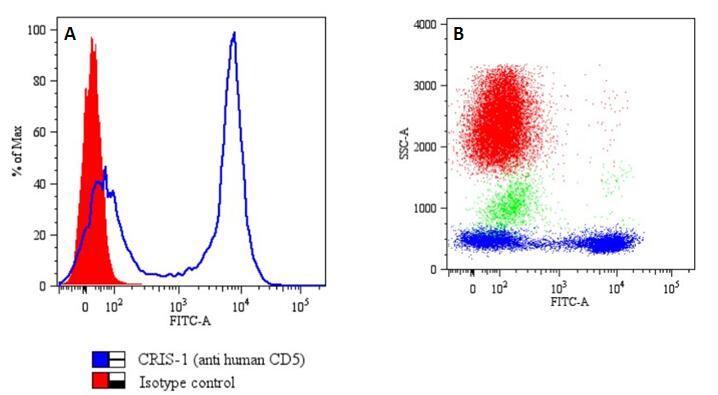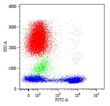CD5 Mouse Monoclonal Antibody [Clone ID: CRIS1]
CAT#: AM03103PU-N
CD5 mouse monoclonal antibody, clone CRIS1, Aff - Purified
Other products for "CD5"
Specifications
| Product Data | |
| Clone Name | CRIS1 |
| Applications | ELISA, FC, IHC, IP, WB |
| Recommended Dilution | Immunoprecipitation. Flow cytometry: 1 μg/ml Positive Control: Peripheral Blood Lymphocytes (PBL) Jurkat human leukemia T-cell line. HPB human leukemia T-cell line. MOLT-4 human leukemia T-cell line. Western blot: Laurylmaltoside lysing buffer; non-reducing conditions; 1-2 μg/ml. Positive Control: Jurkat human leukemia T-cell line. HPB human leukemia T-cell line. Immunohistochemistry (Frozen sections). ELISA: Can be used in the Sandwich ELISA as the detection antibody in pair with the capture antibody MEM-32. |
| Reactivities | Human |
| Host | Mouse |
| Isotype | IgG2a |
| Clonality | Monoclonal |
| Immunogen | Stimulated human leukocytes. |
| Specificity | The antibody CRIS1 reacts with the cell surface glycoprotein CD5, a 67kDa single-chain transmembrane glycoprotein expressed on mature T lymphocytes, most of thymocytes and B lymphocytes subset (B-1a lymphocytes). |
| Formulation | PBS, pH 7.4 with 15 mM sodium azide as preservative. State: Aff - Purified State: Liquid purified IgG fraction (> 95% pure by SDS-PAGE). |
| Concentration | lot specific |
| Purification | Affinity Chromatography on Protein-A. |
| Conjugation | Unconjugated |
| Storage | Store the antibody undiluted at 2-8°C for one month or (in aliquots) at -20°C for longer. Avoid repeated freezing and thawing. |
| Stability | Shelf life: one year from despatch. |
| Gene Name | CD5 molecule |
| Database Link | |
| Background | CD5 antigen (T1; 67 kDa) is a human cell surface T-lymphocyte single-chain transmembrane glycoprotein. CD5 is expressed on all mature T-lymphocytes, most of thymocytes, subset of B-lymphocytes and on many T-cell leukemias and lymphomas. It is a type I membrane glycoprotein whose extracellular region contains three scavenger receptor cysteine-rich (SRCR) domains. The CD5 is a signal transducing molecule whose cytoplasmic tail is devoid of any intrinsic catalytic activity. CD5 modulates signaling through the antigen-specific receptor complex (TCR and BCR). CD5 crosslinking induces extracellular Ca++ mobilization, tyrosine phosphorylation of intracellular proteins and DAG production. Preliminary evidence shows protein associations with ZAP-70, p56lck, p59fyn, PC-PLC, etc. CD5 may serve as a dual receptor, giving either stimulatory or inhibitory signals depending both on the cell type and development stage. In thymocytes and B1a cells seems to provide inhibitory signals, in peripheral mature T lymhocytes it acts as a costimulatory signal receptor. CD5 is the phenotypic marker of a B cell subpopulation involved in the production of autoreactive antibodies. Disease relevance: CD5 is a phenotypic marker for some B cell lymphoproliferative disorders (B-CLL, Hairy cell leukemia, etc.). The CD5+ popuation is expanded in some autoimmune disorders (Rheumatoid Arthritis, etc.). Herpes virus infections induce loss of CD5 expression in the expanded CD8+ human T cells. |
| Synonyms | CD5, LEU1 |
| Reference Data | |
Documents
| Product Manuals |
| FAQs |
| SDS |
{0} Product Review(s)
0 Product Review(s)
Submit review
Be the first one to submit a review
Product Citations
*Delivery time may vary from web posted schedule. Occasional delays may occur due to unforeseen
complexities in the preparation of your product. International customers may expect an additional 1-2 weeks
in shipping.






























































































































































































































































 Germany
Germany
 Japan
Japan
 United Kingdom
United Kingdom
 China
China




